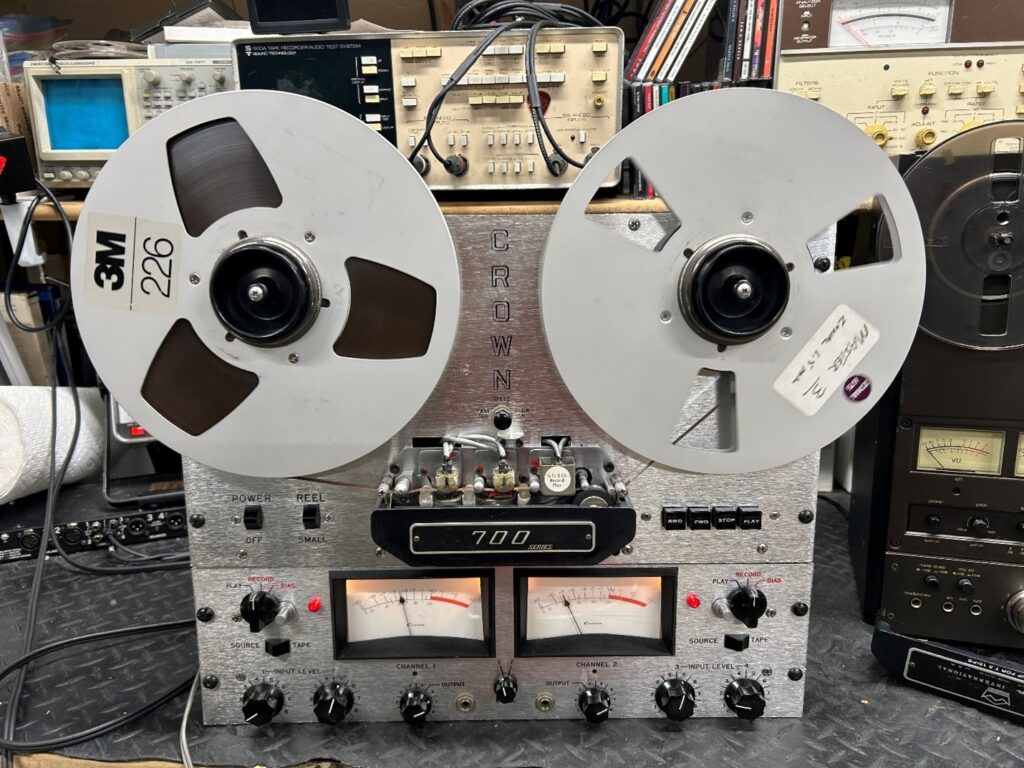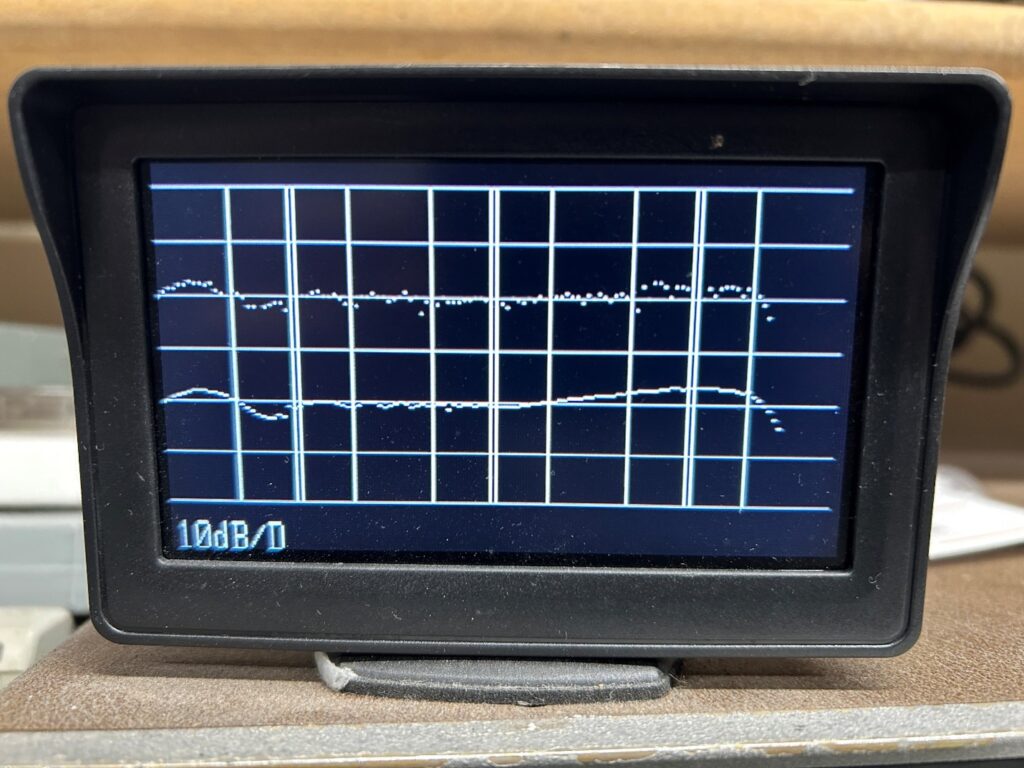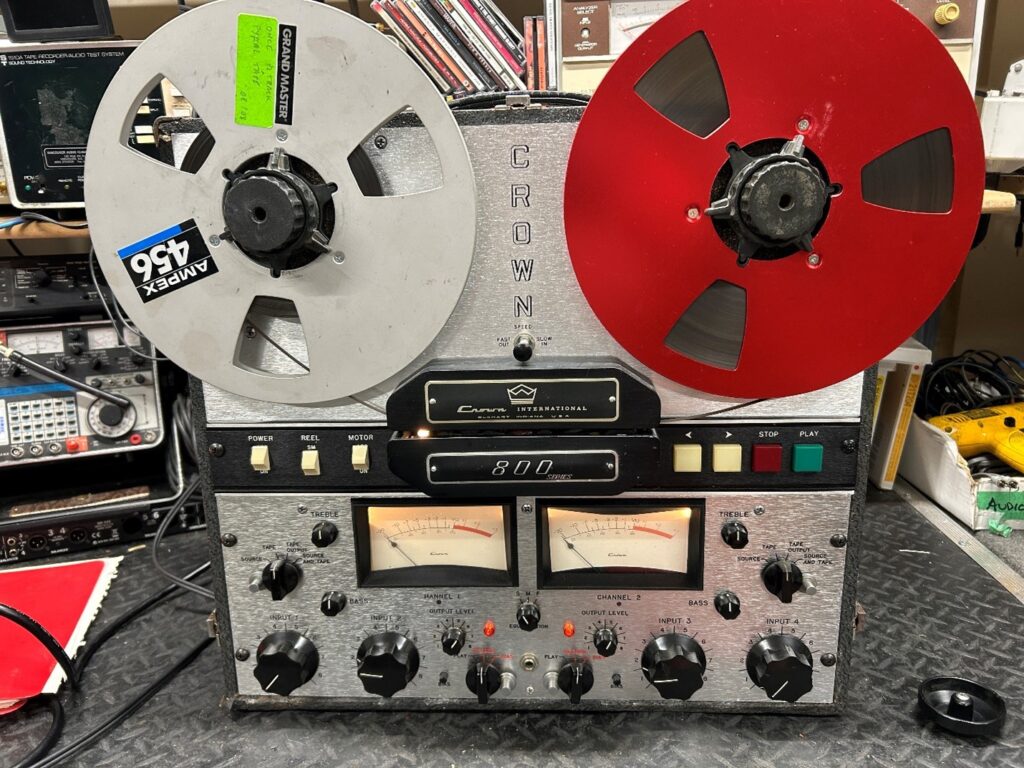The Crown company started in 1947, and started making robust reel to reel tape decks used in remote places in the world, as missionaries would head into the field to spread their word. Sometimes these Crown decks would get parachuted to these locations, so the decks had to be bulletproof, and easy to service in the field. The Crown factory was located originally in Elkhart, Indiana.
Harman International (Harman Kardon, JBL, etc) bought Crown in 2000, and then Samsung bought Harman in 2017.
While we haven’t serviced all of the Crown models, we’ve seen a good cross-section through here over the last 15 years to have a good grasp of their internal workings. In 2025 we rebuilt an early Crown Royal, dating from the mid to late 1950s. Crown incorporated several innovations, such as electronic braking (applying a DC voltage to the AC powered reel motors to slow them down), which was fairly unique, especially when it comes to reel to reel decks. The concept works flawlessly, and as a result, there are no brake bands to wear out on the Crown decks.

As expected with a deck that is 70+ years old, the electronics needed a full recapping, which was time consuming but easily done. This deck ended up with a bit of shipping damage as well, and we had to order a few replacement tubes. Fortunately, no custom Crown parts were needed for the rebuild, and the built in 20 watt tube amplifiers worked to spec.
One thing no longer available for the older Crown decks are the heads, that were made by the Brush company (who built one of the first available reel to reel models, the BK-401.) With the deck we had in for servicing, the heads were pretty far gone, but overall, all things considered, the deck still was able to record and play back at an acceptable level. Don’t expect much past 10Khz on a deck this old though.
Many Crown decks came with a heavy duty case, complete with carrying handles, and front and back latching doors.
Crown 700 and 800 series
In the mid 1960s, Crown introduced their 700 and 800 series of decks. These were solid state, with the 800 series being a bit more deluxe than the 700. The 700 series generally used relays to switch the transport, whereas the 800 series used an early TTL logic switching PC board for slightly better handling of the tape transport. Electronic braking was used throughout these two models as well, and tape handling is excellent.
The model numbers indicated the amount of channels, and the track configuration. The first number of the model is the series, being the 700 or 800 series. The second number indicates how many channels the deck has, and the third number is whether the deck is ¼ track or ½ track.
Therefore, a CX824 uses the CX series electronics, is an 800 series transport, and is a 2 channel, ¼ track deck.
An SX 744 uses the SX series of electronics, has a 700 series transport, and is a 4 channel, ¼ track deck.
There were two versions of electronics for the 700 and 800 series, the SX and the CX. The CX series was the more deluxe model, using interchangeable PC boards for most of the electronics, and also had bass and treble controls on the front of the deck.

The Crown decks used a very basic transport, with a dual pulley system and a belt drive capstan shaft. A simple push-pull plunger would force the capstan belt onto the two sections of the capstan motor pulley, changing the speeds. Given that these decks came out in the 1960s, and full logic control was not yet possible with these decks, Crown got clever with certain aspects of the deck, such as the record function. A latching rotary switch selected the record function of each channel, and when the deck was placed in record mode, the rewind function would be locked out, so that you couldn’t rewind your newly recorded tape.
Mechanically speaking, the decks are generally very serviceable with a basic set of tools, however, one model that was only made for 2 years, the SS824 (SS standing for ‘solid state’) had a capstan motor mount that was challenging to swap it out.
Electronics – due to age, and some of the capacitor brands used, every Crown that we’ve had through here has needed a full recapping. Specifically, the capacitors in the later 800 series seem to fail more frequently than the 700 series, but we don’t overhaul a Crown deck without a full recap. Failure to do so is just asking for problems in the near future.
Overall, the deck has very much a ‘tape’ sound to it, in that the decks are not audiophile flat. Instead, the frequency response generally has a 3db bump at 50Hz like many decks, due to the interaction between the head and the tape. The high end isn’t always completely flat either, but considering the age of the design of these decks, along with the technology available at the time, these Crowns were considered to be of audiophile quality.
If you don’t want a ‘sterile’ sounding deck like a Revox or Studer, then the Crown is an excellent choice for adding some analog tape artifacts to your recordings.

Pros:
- cutting edge technology for the time, rivalling decks like Ampex and Berlant Concertone
- gentle tape handling
- overbuilt, generally easy to service
- modular construction of the CX series make it easy to work on most of the electronics

Cons
- based on the age, a bit clunky to operate compared to later decks
- motor bearings can get noisy due to age
- full recaps are needed on these due to age at this point
- a bit awkward to switch between play and record functions
- original NAB adapters are hard to find, and many of the current clone adapters will not work on this deck
